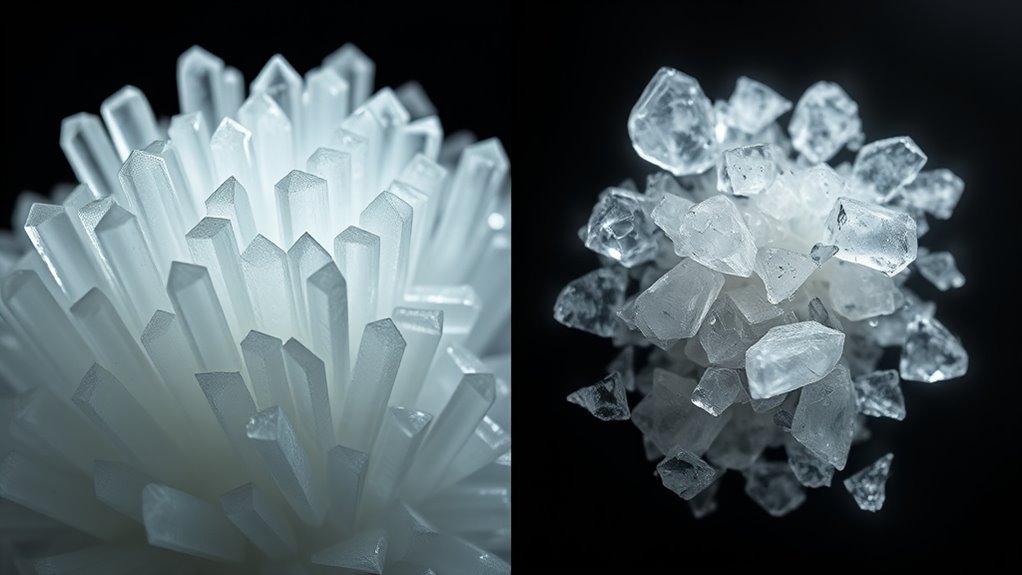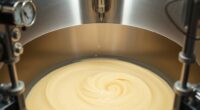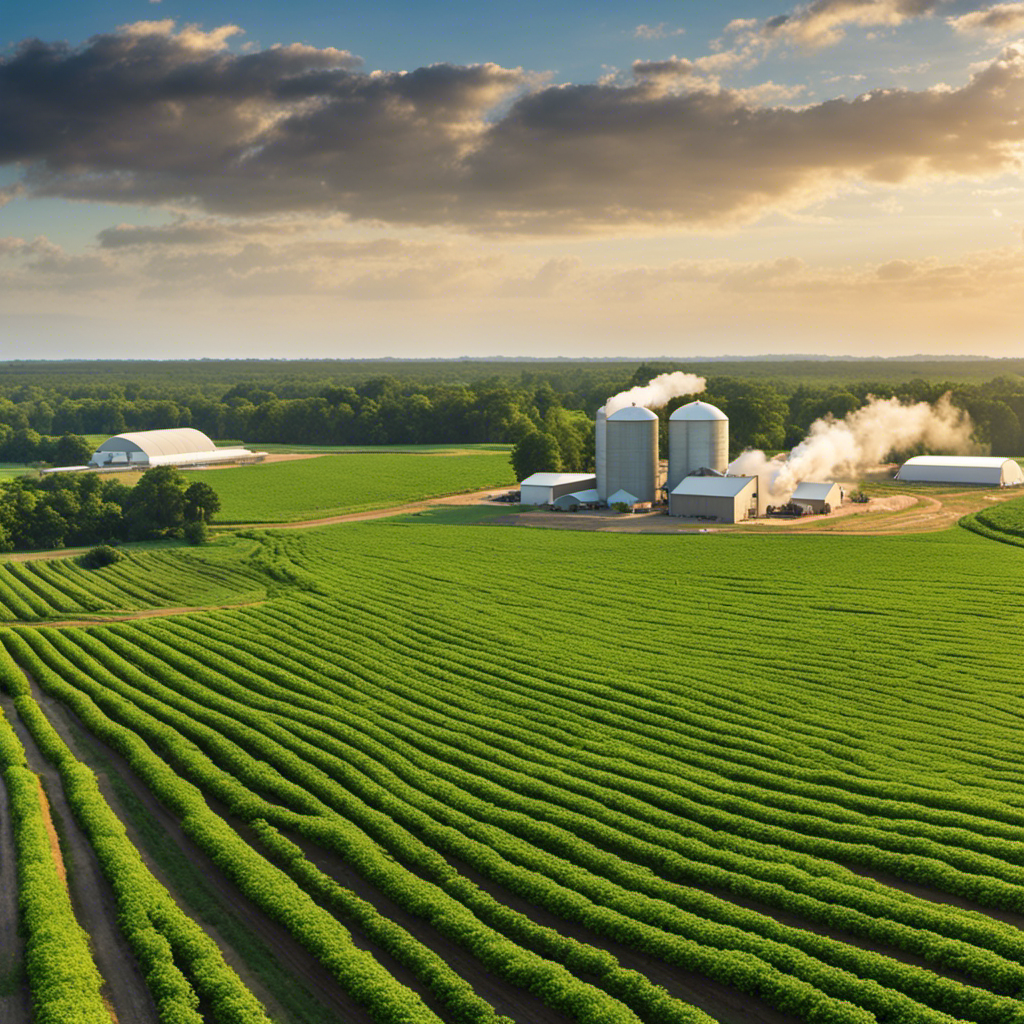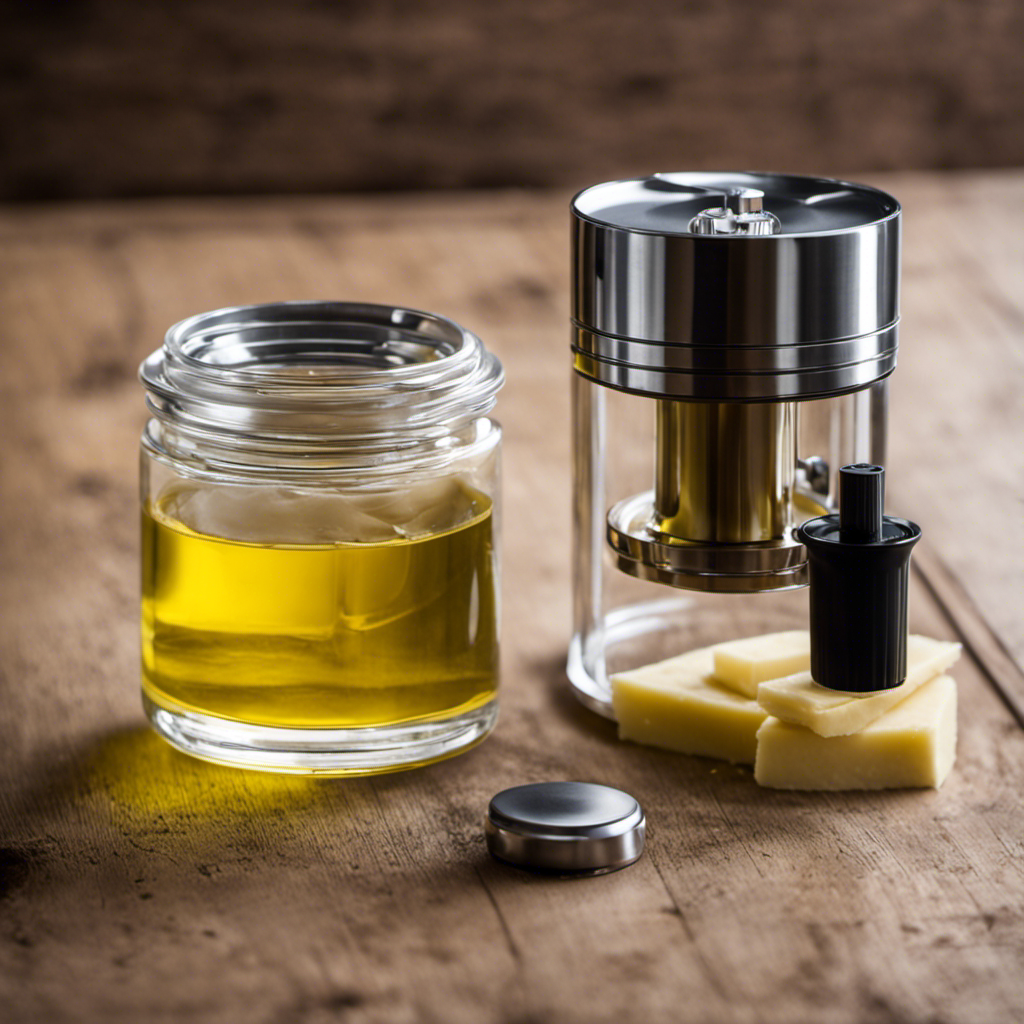High-shear churning creates finer, more uniform crystals with elongated shapes, thanks to intense mixing and increased nucleation rates. Low-shear produces larger, more irregular crystals, leading to broader size distributions and less uniformity. Shear level also affects impurity distribution—high shear can entrap impurities more easily, while low shear allows for better purification. To optimize crystal features and purity, understanding how shear influences structure can make a big difference—if you want to explore further, keep going.
Key Takeaways
- High shear promotes the formation of smaller, more uniform crystals with elongated structures, while low shear results in larger, more randomized crystals.
- Increased shear rates enhance nucleation, producing numerous tiny crystals; low shear favors fewer, larger crystals due to slower nucleation.
- High shear can lead to greater impurity entrapment within crystals, whereas low shear typically results in more homogeneous impurity distribution.
- Shear intensity influences surface roughness and morphology, with high shear yielding smoother, well-oriented crystals, and low shear producing rougher, irregular structures.
- Balancing shear levels is essential to control crystallinity, impurity incorporation, and material homogeneity for desired crystalline properties.
Differences in Mixing Intensity and Their Effects
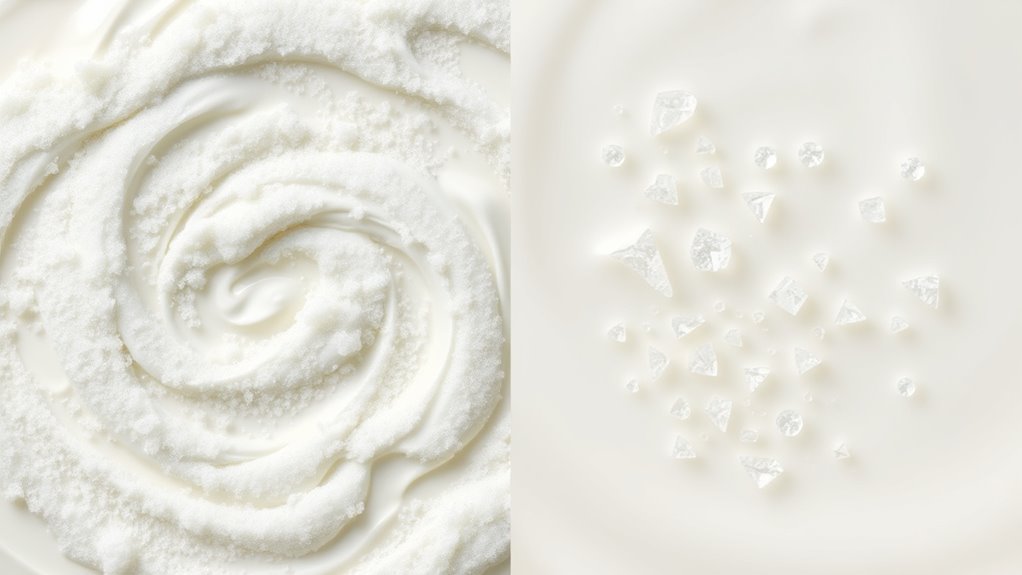
High-shear and low-shear churning differ mainly in their mixing intensity, which directly impacts the size and distribution of particles within a mixture. With high-shear churning, you deliver a greater energy input, causing vigorous agitation that breaks down particles and promotes uniform dispersion. This process ensures better mixing uniformity, especially for delicate or complex formulations. In contrast, low-shear churning applies gentler energy, resulting in larger particles and less consistent distribution. Your choice of shear level influences not only particle size but also the homogeneity of the mixture. High-shear methods excel when you need fine, evenly distributed particles, while low-shear techniques suit applications requiring gentler mixing to prevent damage or agglomeration. Ultimately, understanding these differences helps you optimize your process for the desired crystalline structure. Additionally, selecting the appropriate shear level can influence the color accuracy and overall image quality in applications like home cinema projectors, where uniform and precise crystalline structures are essential.
Nucleation Rates Under Varying Shear Conditions
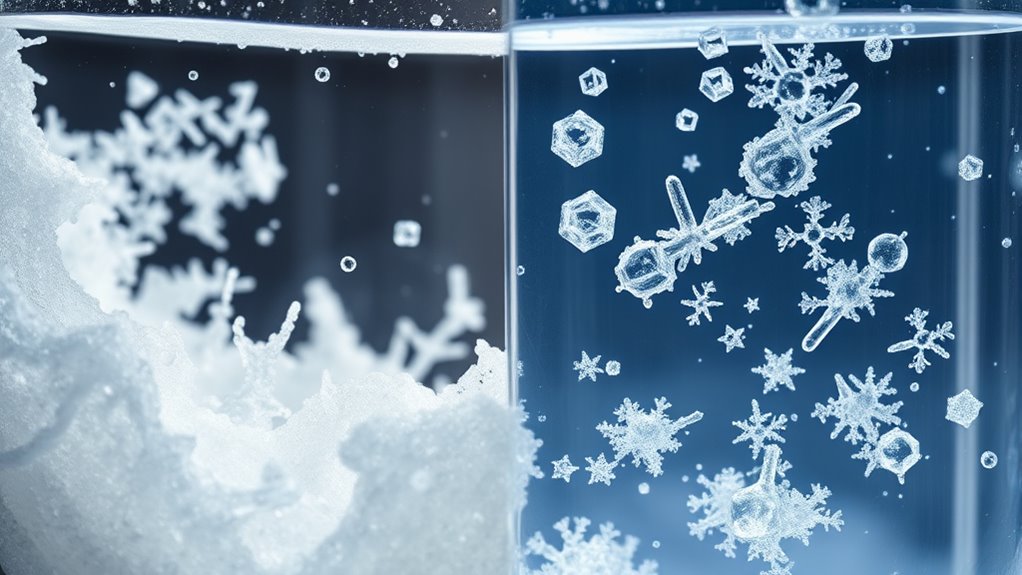
The rate at which nucleation occurs during mixing is heavily influenced by shear conditions, as the energy input directly affects molecular interactions and phase shifts. In shear flow, higher shear rates increase the likelihood of nucleation by promoting the formation of critical nuclei through enhanced molecular collisions. Low shear, on the other hand, tends to slow nucleation, allowing larger, fewer crystals to form. Shear flow can be used as a tool for nucleation control, enabling you to adjust the shear rate to either accelerate or suppress nucleation depending on your desired crystalline structure. By understanding how shear conditions impact nucleation rates, you can optimize the mixing process to achieve consistent, uniform crystals, which is vital for product quality and performance. Online resources are available to help monitor and adjust shear parameters effectively during processing.
Crystal Growth Dynamics in High-Shear Environments
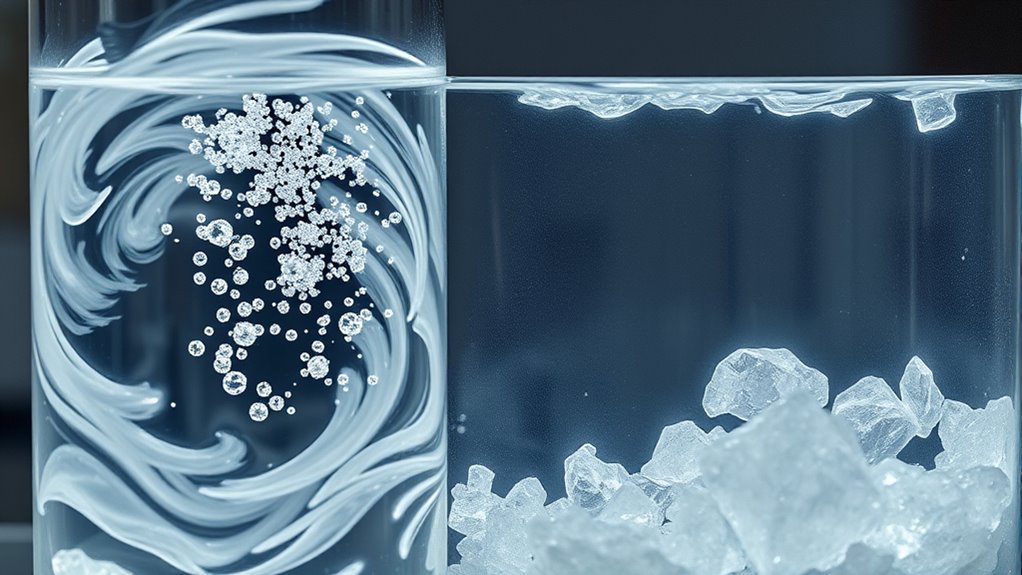
In high-shear environments, crystal growth dynamics are markedly affected by the intense mixing forces that influence particle interactions and mass transfer rates. These forces can accelerate or hinder crystal development, depending on shear intensity. High shear often promotes rapid growth near the amorphous transition, where materials shift from disordered to ordered states. This turbulence can prevent stable nuclei from forming, delaying or disrupting glass formation. Conversely, in some cases, shear enhances mass transfer, leading to more uniform crystal growth. You’ll notice that shear-induced stresses can modify the crystalline structure’s size and quality, often resulting in smaller, less perfect crystals. Understanding these dynamics helps optimize processes, balancing shear levels to control crystallinity and prevent undesirable amorphous or glassy phases. Regularly assess and rotate items can be a helpful analogy for monitoring and adjusting shear conditions to optimize crystal quality.
Morphological Variations Induced by Shear Levels
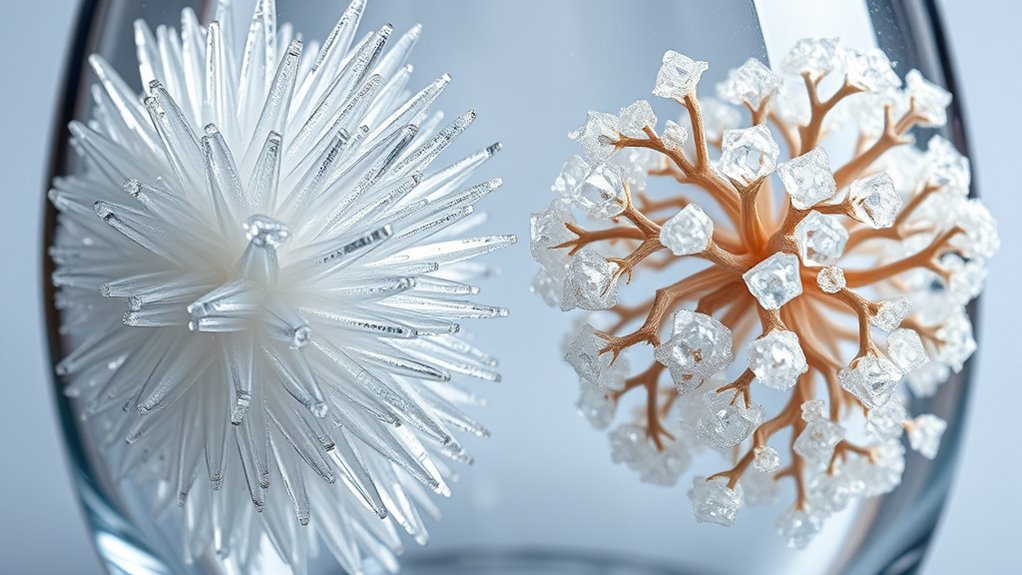
Shear levels considerably influence crystal size, often producing smaller crystals under high shear. You’ll notice how morphology and texture shift with varying shear forces, affecting the material’s properties. Additionally, nucleation patterns change, leading to different structural arrangements depending on whether shear is high or low. Understanding personal development techniques like visualization can also help optimize your approach to mastering material science concepts.
Crystal Size Differences
Shear levels directly influence crystal size, with high shear producing smaller, more uniform crystals and low shear resulting in larger, less uniform ones. In high-shear environments, rapid nucleation limits crystal growth, leading to fine grains with numerous grain boundaries. These boundaries act as barriers, restricting crystal expansion and reducing defect formation within each crystal. Open dialogue and vulnerability can enhance understanding and connection between partners, emphasizing the importance of communication even in scientific contexts. Conversely, low shear allows crystals to grow larger over time, resulting in fewer grain boundaries but increased susceptibility to defects like dislocations. The size and distribution of crystals markedly affect material properties, with smaller crystals offering higher strength and stability. Understanding how shear influences crystal size helps you tailor processing conditions to achieve desired crystalline structures, optimizing performance for specific applications.
Morphology and Texture
Different shear levels markedly influence the morphology and texture of crystalline materials by altering how crystals develop and align during processing. High shear can produce elongated, well-oriented structures, reducing grain boundary complexity and surface roughness, leading to a sleek appearance. Conversely, low shear encourages more randomized crystal growth, increasing grain boundaries and surface unevenness.
You will notice:
- Sharper grain boundaries under low shear, making surfaces rougher.
- Aligned crystal structures with high shear, enhancing smoothness.
- Less uniform surface roughness in low-shear processes, creating texture variations.
- Distinct morphological features that influence material strength and appearance.
Understanding these variations helps you tailor processing to achieve desired crystalline textures efficiently.
Nucleation Patterns
Nucleation patterns in crystalline materials are considerably influenced by shear levels during processing, which determine how and where new crystals form. High shear often creates numerous nucleation sites, leading to a higher defect density and finer grain boundary networks. Low shear, on the other hand, results in fewer nucleation points, producing larger grains with less complex grain boundaries. The shear intensity affects the distribution and morphology of nuclei, shaping the crystalline structure’s overall appearance. To illustrate:
| Shear Level | Nucleation Characteristics |
|---|---|
| High shear | Numerous nuclei, high defect density, fine grains |
| Low shear | Fewer nuclei, larger grains, smoother boundaries |
Understanding these patterns helps optimize processing conditions for desired crystal properties.
Impact on Crystal Size Distribution and Uniformity
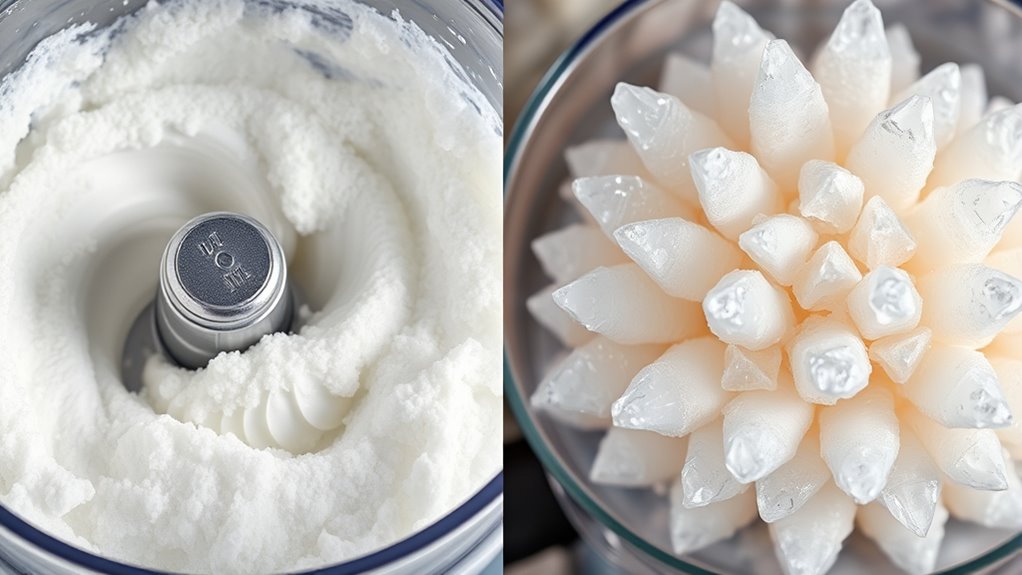
The level of shear applied during churning considerably influences the size and uniformity of crystals formed. High shear promotes grain refinement, resulting in smaller, more uniform crystals that enhance consistency. Conversely, low shear tends to produce broader size distribution, leading to less uniformity. This directly affects product quality and processing efficiency. Consider these key impacts:
- Achieves tighter control over grain refinement, boosting overall material strength.
- guarantees more consistent size distribution, reducing defects.
- Enhances uniformity, leading to predictable performance.
- Minimizes variability, increasing manufacturing reliability.
Influence on Material Purity and Impurities Distribution

Your churning method directly influences how impurities incorporate into the material, affecting overall purity. High-shear processes tend to cause uneven impurity distribution, while low-shear methods promote more consistent purification. Understanding these patterns helps you optimize for crystalline homogeneity and purification efficiency.
Impurity Incorporation Patterns
Impurity incorporation patterns during high-shear and low-shear churning markedly affect the overall purity of the final material. When shear exceeds the shear threshold, solvent interactions become more dynamic, increasing the likelihood of impurities embedding into the crystal lattice. Under low-shear conditions, impurities tend to segregate, leading to uneven distribution. You’ll notice:
- Inconsistent impurity zones that compromise material strength.
- Enhanced impurity entrapment during high-shear, risking contamination.
- Localized impurity clusters forming near shear hotspots.
- Differential distribution patterns driven by shear intensity and solvent behavior.
Understanding these patterns helps you control impurity levels and optimize the churning process, ensuring higher purity and improved crystalline quality. Your ability to manipulate shear conditions directly influences impurity incorporation and material excellence.
Purification Efficiency Variations
Variations in purification efficiency during churning considerably influence both the overall material purity and the distribution of residual impurities. When solvent interactions change, impurities may either be effectively removed or become trapped, depending on the process conditions. Temperature fluctuations also play a critical role; higher or inconsistent temperatures can hinder impurity solubility, reducing purification efficiency. In high-shear environments, rapid mixing can enhance impurity removal by promoting better solvent interactions, but excessive shear might cause impurity entrapment in the crystalline matrix. Conversely, low-shear churning often results in uneven impurity distribution due to less effective solvent contact. Overall, maintaining stable temperature conditions and optimizing shear levels are essential to improve purification outcomes and guarantee consistent material purity. Additionally, glycolic acid products can be used to improve exfoliation and skin clarity, which underscores the importance of process control in achieving desired purity levels.
Crystalline Homogeneity Effects
Crystalline homogeneity considerably influences both the purity of the final material and how impurities are distributed throughout the product. When the structure is uniform, impurities spread evenly, reducing weak points caused by amorphous regions and lattice distortions. Conversely, inhomogeneity leads to uneven impurity distribution, creating vulnerable areas prone to failure. By controlling the churning process, you can minimize amorphous regions and lattice distortions, achieving a more consistent crystalline structure. This consistency enhances material strength and purity, ultimately improving performance. A well-formed crystalline structure is also essential for understanding dog breeds and their characteristics, which can influence material selection and application. Consider these impacts:
- Enhanced Purity boosts overall material quality.
- Even Impurity Distribution prevents weak spots.
- Reduced Amorphous Regions strengthens the crystalline matrix.
- Minimized Lattice Distortions ensures structural integrity.
Practical Implications for Manufacturing Processes

Choosing between high-shear and low-shear churning can substantially impact your manufacturing process, affecting product quality, efficiency, and consistency. High-shear equipment often increases energy efficiency by reducing processing time, but it may demand more frequent maintenance due to greater wear and tear. Low-shear methods tend to be gentler on equipment, lowering maintenance costs, but might require longer processing times, potentially reducing overall efficiency. Your choice influences operational costs, product uniformity, and scalability. High-shear processes can produce more consistent crystalline structures, but at the expense of higher energy consumption and maintenance needs. Conversely, low-shear churning may save on maintenance but could lead to variability in product quality. Balancing these factors helps optimize your manufacturing process for both performance and longevity. Additionally, understanding the comparative advantage of each method can guide decision-making to maximize productivity while maintaining quality standards.
Selecting the Appropriate Shear Level for Desired Properties

Selecting the right shear level directly influences the properties of your final product. Adjusting the shear rate allows you to control crystalline structures, impacting texture, stability, and appearance. To choose the ideal shear level, consider these factors: creating a cozy farmhouse bedroom ambience, as the atmosphere can influence the perception of the final product’s quality and appeal. 1. Desired product characteristics—decide if you need a finer or coarser crystalline structure. 2. Shear rate flexibility—higher shear rates often produce more uniform crystals but may complicate process scalability. 3. process scalability—ensure the shear level you select can be maintained efficiently at larger production volumes. 4. Product consistency—balance shear intensity to achieve reliable properties without compromising manufacturing efficiency.
Frequently Asked Questions
How Does Shear Rate Influence the Energy Consumption During Churning?
You’ll notice that increasing shear rate during churning raises energy consumption, which can impact your process’s energy efficiency. Higher shear rates require more mechanical power, making the process less efficient if not optimized. To improve energy efficiency, you should carefully control shear conditions, balancing the shear rate to optimize the process without unnecessary energy use. This approach helps in process optimization, saving energy and enhancing overall product quality.
Can Shear Level Adjustments Be Used to Tailor Specific Crystal Morphologies?
Oh sure, just turn the shear level dial and voilà—you’ve got perfect crystal shape, right? In reality, adjusting shear levels lets you control morphology by influencing crystal growth patterns. Higher shear often produces smaller, more uniform crystals, while lower shear fosters larger, elongated forms. So yes, shear adjustments are a practical way to tailor crystal shape and morphology control, giving you some say in your final product’s structure.
What Are the Environmental Impacts of High-Shear Versus Low-Shear Processes?
You want to understand the environmental impacts of high-shear versus low-shear processes. High-shear methods often consume more energy, increasing your environmental footprint and potentially leading to higher pollutant emissions. Low-shear processes tend to be gentler, using less energy and producing fewer emissions. By choosing the right shear level, you can reduce your process’s environmental impact, lowering emissions and promoting more sustainable manufacturing practices.
How Does Shear Intensity Affect the Scalability of Crystallization Operations?
You’ll find that shear intensity impacts the scalability of crystallization operations by creating challenges with shear uniformity. High shear can lead to inconsistent crystal sizes, complicating scale-up, while low shear offers more uniform conditions but might slow down production. Balancing shear levels guarantees smoother scalability, reduces challenges, and maintains product quality. Adjusting shear intensity thoughtfully helps you manage these scalability challenges effectively, ensuring your process remains efficient at larger scales.
Are There Specific Materials More Suited to High-Shear or Low-Shear Crystallization?
Imagine you’re in a vintage candy shop, choosing the perfect ingredients. You’ll find that material compatibility and crystallization kinetics determine whether a material suits high-shear or low-shear processes. Some materials, like pharmaceuticals requiring precise crystal forms, prefer low-shear for gentle control. Others, like certain salts, benefit from high-shear to accelerate crystallization. Your choice hinges on understanding how shear impacts crystal growth and the material’s specific properties.
Conclusion
Choosing the right shear level can make or break your crystalline product. High shear accelerates nucleation and creates finer, more uniform crystals, but risks introducing impurities. Low shear offers gentler growth, yielding larger, purer crystals. Remember, the shear environment is your secret weapon—get it right, and you could revolutionize your manufacturing process. Don’t underestimate the power of shear; it’s the tiniest tweak that can release extraordinary material properties.
